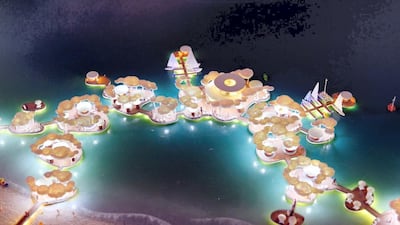Latest: Everything you need to know about Dubai 2040 Urban Master Plan
Sheikh Mohammed bin Rashid, Vice President and Ruler of Dubai, set forward a plan to overhaul the emirate's urban landscape, dramatically increasing community, economic and recreational areas, as well as nature reserves, by 2040.
The goal, he said on Saturday during the launch of the plan, was for Dubai to become the best city to live in for the estimated 5.8 million expected to reside there in 20 years.
Areas for economic and recreational activities will grow by one and a half times, and the length of beaches will increase by 400 per cent over the next 20 years, Sheikh Mohammed said on Twitter, sharing renderings of the proposed plans.
Part of those plans include vast swathes of green areas in the city, with 60 per cent of Dubai to be dedicated to nature reserves.
The emirate will be split into five main urban areas, focusing the main draws of the city to specific zones: Deira / Bur Dubai (city's historical essence), Downtown / Business Bay (global financial hub), Dubai Marina / JBR (tourism and entertainment), Expo 2020 (international gate for exhibitions and events), and Dubai Silicon Oasis (knowledge and innovation centre).
The "people-led" development aims to increase a sense of community across the emirate, designating integrated service centres in each area and improving interconnectivity by ensuring 55 per cent of the population will live within 800 metres of a main public transport station.
Spaces designated for educational and health facilities will increase by 25 per cent and areas for hotels and tourism will rise by 134 per cent.
Images of the master plan showed an area allocated for the emirate's third airport, just outside Dubai Silicon Oasis.
"The goal of the new Dubai urban plan is to plan life in [the city] over the next 20 years," Sheikh Mohammed said.

He said the plan would provide "the best and finest" quality of living for the population.
"And to prepare for the upcoming major demographic and economic developments in Dubai. We ask God to help everyone to serve the country and the people," he said.
Along with the physical plan, an Urban Planning Law was issued to support sustainable development and improvement in the emirate.
Dubai 2040 is the seventh urban plan to be brought into the emirate since 1960, 11 years before the unification of the UAE. Between then and today, the city's population has grown from 40,000 to 3.3 million.
The urban and developed areas of the emirate increased from 3.2 square kilometres to 1,490 sq km.
Under the plan, old districts will be revitalised and designated as Emirati housing.
Hatta, an area of Dubai in the eastern part of the country, is also included in Dubai 2040, with plans for a sustainable hydro-electric power plant and increasing tourism and agriculture contribution to the region's GDP by 32 per cent.
At least 78 per cent Hatta will be designated as conservation reserves, as the population is expected to double by 2040.
The plan was initially announced in October last year, with Sheikh Mohammed saying Dubai would create a dozen new beaches and 8 million square metres of green spaces at a cost of more than Dh2.5 billion ($680 million)
The 29 projects include more spaces for swimming, better running paths and longer cycling lanes
“We also approved the development of 12 kilometres of Dubai's beaches, that cover 1 million square meters, from Mamzar Beach to Umm Suqeim II,” Sheikh Mohammed said at the time.
The beach projects were being developed at a cost of Dh500m.
The project aims to revitalise the beachfront and increase swimming areas, reported state news agency Wam.
Dedicated areas for water activities and jogging and cycling tracks will be provided as part of the overall plan to promote a fitness culture and healthy lifestyle among the city’s residents.
























